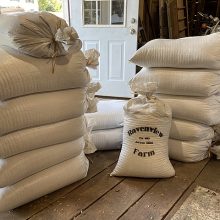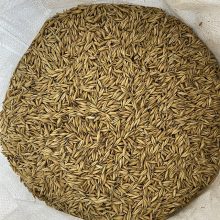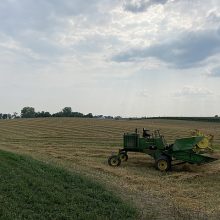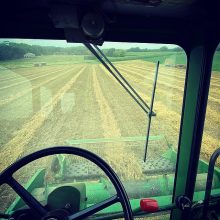Oats
Bags of Oats are 40 lbs and cost $8 per bag
Back in stock for 2024 and until we run out sometime in 2025! This year we planted six acres of Minnesota Pearl oats. They did quite well, and were harvested in late July. They’ve been run through the fanning mill to remove dirt, debris and weed seeds. These oats are great feed for horses and other domestic livestock, wildlife, and as an ingredient in poultry scratch grains. They are not for human consumption, since they are a hulled oat (unless you have an oat de-hulling machine, which is a pretty uncommon device).
These oats are non-GMO. They were grown without any artificial fertilizer, zero pesticide or fungicide, and only received one spray pass of 2-4D in mid-May to control broadleaf weeds. We never chemically terminate our oats. They are swathed and left to dry in the windrow for a few days before combining.
(fun fact, there is no such thing as a GMO oat variety. They’re all bred through traditional cross-breeding. I get asked that question a lot!)
Call or text Mike at 612-366-5249
or email us at RavenviewFarm@gmail.com
to place your order
We offer delivery in the Jordan, MN area
Rates will depend on mileage and quantity ordered
We accept cash, local checks, and Venmo
Do you ever wonder why farms only grow corn and soybeans these days? We sure do. Nature doesn’t ever do just one thing at a time, and you’ll be awfully hard pressed to find a healthy ecosystem that’s based on a monoculture. To that end, we’ve been trying to diversify our crop rotation here on the farm, and move away from the “only corn and soybeans forever” model of farming.
Grandpa grew oats here. He needed them for the feed ration – for working horses originally, and then as an ingredient for his hog and cattle feed. The straw was used for bedding and then went back onto the fields with the animal manure. Nothing went to waste.
Now, we’ve brought oats back to the farm as a grain crop after 30+ years. We’re using them to give the land a break from the corn and soybean merry-go-round. Harvesting the oats in early August helps break the weed cycle, and spreads out our work load. We can underseed the oat crop with alfalfa or clover, or establish a winter-hardy cover crop after harvest. Eventually, we’re hoping to bring livestock back to the farm, and a small grain crop will offer us opportunities to graze cattle out on the fields.



